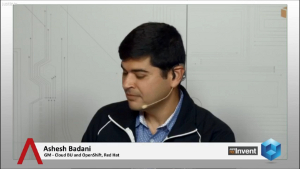 NEWS
NEWS
 NEWS
NEWS
 NEWS
NEWS
![]() Ashesh Badani, GM, Cloud BU and OpenShift at Red Hat, discussed the company’s platform as a service offering, their experience with AWS with theCUBE co-hosts Dave Vellante and Stu Miniman, live from the re:Invent conference
Ashesh Badani, GM, Cloud BU and OpenShift at Red Hat, discussed the company’s platform as a service offering, their experience with AWS with theCUBE co-hosts Dave Vellante and Stu Miniman, live from the re:Invent conference
“I focus my time on OpenShift platform as a service (PaaS) area,” Badani said, explaining his role at Red Hat. There was “a bunch of cloud technology that we work with at RedHat and associated technologies that go with cloud, like storage.”
“We’re running OpenShift online over AWS for over two years now,” Badani said. “Ever since then we realized developers want choice.” Red wanted to reach out to developers in the Linux area and Java communities, to make sure they could reach out to people using Ruby or PHP, but did not have an offer for them.
“We realized there was a whole movement to the cloud, we wanted to make sure we had a public cloud offering.” That helped them understand the total addressable market (TAM) for PaaS was both around the public area comprising those who “have nothing to do at all with the online software,” and another group that finds value in Private PaaS. The total TAM is $14-20 billion, Badani said, for both public and private PaaS.
Discussing the change in the PaaS conversation in the past 6-12 months, Badani said “there is a lot of confusion in the marketplace.” There are complex concepts out and as there is more knowledge in the marketplace, the conversation changes. When talking to customers, large financial institutions, government agencies evaluating private PaaS, they want to talk to people in the organization that already use OpenShift’s private PaaS.
Asked what the adoption in general was, Badani said the best to describe it isere are three flavors of OpenShift: OpenShift Origin – everything available out in the open, OpenShift Online, the public PaaS that stands on AWS which is the only supported public cloud for now, and OpenShift Enterprise – private PaaS, can be run in their own data center or in OpenStack.
“In the last 12 months, every third conversation was about ‘I’m interested in OpenStack.’ Now it’s every other conversation,” Badani said. “We’re believers in community. When OpenStack started, we weren’t the first in, but we are now the largest contributor to it. We’re also seeing interest from a variety of areas,” Badani added, such as compute, storage, but also application lifecycle management. “You have choice that AWS is providing while you don’t have to use all the services, the same holds true from OpenStack.”
Commenting on the recent 50 percent price cut for Red Hat services, Badani said “everyone is cutting prices, everyone wants to support different frameworks and tools.”
Asked for a bumper sticker message for AWS re:invent, Badani said “startups that start with amazon, stay with them, and achieve scale.” It “empowers the users to believe that cloud can deliver true value.”
THANK YOU